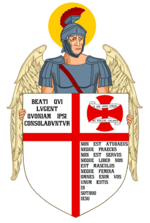Etrurian First Republic
Etrurian Republic Republic of Heaven Reppublica Etruriana Repubblica del Cielo | |
|---|---|
Motto:
| |
Anthem:
| |
| Capital | Tyrrenhus (1784-1787) Solaria (1787-1810) |
| Religion | Solarian Catholicism |
| Demonym(s) | Etrurian |
| Government | Directorial republic (1784-1785) Theo-directorial republic (1785-1810) |
| President of the Convention | |
• 1784 | Aurelio Polizzi |
| Member of the Aventine Triad | |
• 1784-1785 | Francesco Cassio Caciarelli |
• 1784-1785 | Massimiliano Malaspina |
• 1784-1785 | Giovanni-Paolo Danova |
| First Citizen | |
• 1785-1810 | Francesco Cassio Caciarelli |
| Legislature | Senate of the Republic |
| History | |
• Established | 20 January 1784 |
| 9 September 1783 | |
| 3 November 1783 | |
| 20 January 1784 | |
| 10 July 1784 | |
• La Purga | 18 July 1784 |
| 20 July 1784 | |
| 12 August 1810 | |
| Population | |
• 1784 | 18,398,200 |
• 1810 | 19,998,200 |
| Currency | Etrurian piastra |
| Today part of | Etruria Gaullica Piraea Galenia |
The Etrurian First Republic (Prima Repubblica Etruriana), officially known as the Etrurian Republic (Repubblica Etruriana) and co-officially known as the Republic of Heaven (Repubblica del Cielo), was founded on 20 September 1784, during the Etrurian Revolution. The First Republic would end with the Caltrini Restoration on 18 August 1810. Throughout most of its existence, the First Republic was governed by the Pantheonisti faction, under a theocratic directorial republican system. The period of the First Republic was characterised by the overthrow of the Grand Principality of Tyrrenhus, the establishment of the Popular Convention, the Aventine Triad, the Pantheonisti led La Purga, its subsequent domination, the Republic of Heaven period, the Revolutionary Wars, La Tempesta and finally, its demise with the Caltrini Reactions and the Caltrini Restoration.
Though the initial revolution within Tyrrenhus established the Popular Convention, infighting between the three principal factions over the direction of the newly formed Republic would escalate into the La Purga, a violent coup d’état instigated by the Pantheonisti. This group, defined by its esoteric mixing of enlightenment ideals and Catholicism immediately issued the Devotion of the Republic to Heaven, which instilled their ideals in the nascent Republic. This was followed by various Bonfires, with each constituting the targeting of a specific culture or supposed threat to the Republic.
Almost instantly in wake of the La Purga, the Republic found itself at war with its fellow Etrurian states, in what became known as the War of the League. The Kingdoms of Novalia and Carinthia together with the Duchies of Dinara and Peravia dispatched armies to restore the Principality, they were successively defeated by the Republic and suffered counter-invasion, resulting in the collapse and annexation of Carinthia and Novalia by 1786. In 1787, the War of the Northern League began, with the recently re-proclaimed Etrurian Republic launching invasions of Carvagna, Torrazzia and Povelia, annexing them with little to no resistance. Fighting between the Republic and the two northern Duchies ended with their annexation in 1789. This was followed from 1790 onward with numerous wars against Etruria’s neighbours, including Paretia and Gaullica. In one of the most pivotal moments in Eastern Euclean history, in 1789, republican armies invaded and occupied Solaria, with the aim of forcing the support of Pope Alexander XVIII, who however, fled to Gaullica. Solaria was duly proclaimed the capital of the Republic, restoring the city as the capital of a united Etruria for the first time since the Solarian Empire’s demise in 475.
During its existence, the Etrurian First Republic instituted numerous reforms. These included the introduction of universal suffrage for men and women aged 21 and over, the abolition of slavery, equality before law, communal property, the banning of interest rates and introduction of debt forgiveness and a codified law system, while a highly modified version of Werania’s Code of the Rights of Man was enforced through law. However, the Republic due to its own paranoia and state promoted mass violence also took to more radical decisions, such as the attempted effort to abolish currency and restore a bartering based economy, price controls and the enforcement of the Declaration of Rights of State, which proscribed the state’s right to use violence against its population. The most contentious issue of the First Republic was its formulation of the Canon of Heaven’s Devotions, a document which served to encapsulate the ideology of the revolution.
Throughout the 1790s, the Republic scored major victories against its royalist enemies. Its capable officer corps, including Giorlamo lodare-Dio Schiave, Augustino Cesare Santoro and Caio Teme-Dio Trellini and the expertly used Nobilis Hospes, providing the Republic with significant numbers of conscripts, all combined to enable the establishment of Ecumenical Republics in Paretia, Piraea, Amathia and Gaullica. However, economic mismanagement, zealotry and ever-increasing violence domestically began to undermine the Republic. Coupled with growing resistance by the Papacy to what it officially described as an “blasphemous and apostatic science”, popular support began to crumble. In 1802, the Weranian Republic collapsed, enabling the other major Euclean monarchies to aid Gaullica. From 1806 through to 1810, the exiled Etrurian aristocracies united around the House of Caltrini, who returned with a sizeable force in early 1810 and overthrew the Republic as the republican armies disintegrated.
The United Kingdom of Etruria was established several weeks later, though as a constitutional monarchy, rather than absolutist. The legacy of the Etrurian First Republic would live on through parliamentarianism, social welfarism, civic virtue enforced by law, egalitarianism, and a deference of state to the Church. The Republic’s wedding of Catholicism with republicanism and nationalism would play a prominent role within Etrurian society through to the 1880s, when the Caltrini monarchy was overthrown, and would leave marks on neighbouring Gaullica and Paretia.
The First Republic would leave a profound legacy in both Etruria and the wider world, ideologically, politically, economically and religiously. It united the territories of Etruria for the first time since Solarian times and would export its unique theocratic republicanism across much of Southern Euclea, leaving an indelible mark on the evolution of the Catholic Church. In comparison to its rival Weranic Republic, the Etrurian Republic’s ideals and principles of popular universal suffrage, utilitarianism, egalitarianism and a Catholicism-infused Etrurian nationalism, would live on almost a century through the clergy and academic circles, ultimately being reconstituted in some form with the Etrurian Second Republic, following the San Sepulchro Revolution in 1888 that overthrew the Caltrini monarchy.
History
Origin
- Grand Principality of Tyrrenhus is ruled incompetently by successive Grand Princes.
- Near two-decades of war between Tyrrenhus and Povelia over central Vespasia has bankrupted Tyrrenhus and become unpopular
- Successive agitation by clubs, societies and groups.
- Bread riots begin over a taxation on wheat
- Bread riots escalate
- March of the Widows, sees guards open fire on war widows demanding better pensions.
- Mass revolt and overthrow of the monarchy.
Popular Convention
- New national convention is established by former parliamentarians and the three prominent revolutionary groups.
- Groups; Rispettabili (gentleman revolutionaries + cult of reason types), Scugnizzo (radical poor, San Coulettes types), Pantheonisti (theo-republicans)
- Inter factional fighting and disagreements
- Grand Prince's execution
- Rising tensions between the Rispettabili and Pantheonisti over atheist and cult of reason
- Scugnizzo destroyed by Pantheonisti
La Purga
- Pantheonisti stage a coup, capturing, exiling or killing the Rispettabili
- Pantheonisti assumed complete control of the Popular Convention and begin building a loyalist base within the republican armies.
- Secures the backing of the Archbishop of Tyrrenhus and the Principality's clergy (overwhelming majority)
Devotion of the Republic to Heaven

- The Pantheonisti devote the republic to Heaven and vow to instil their ideological tenets.
- First Bonfire of the Heresies is launched, destroying brothels, gambling dens and coffee houses used by the upper-classes.
- War of the League begins with Carinthia, Novalia and the northern states invading Tyrrenhus.
War of the Leagues
- The League makes good progress in the north, though the Republican Armies in the west defeat the joint Carinthian-Novalian invasion at the Battle of Valle Gioviana and Battle of Villa Sirena.
- Republican Armies defeat the northern states at the battles of Santa Cecelia, Margo and Ponte di Rubicon.
- Senate issues edict for the counter-invasion of the western Kingdoms.
- Republican Armies invade Novalia toward Supetar and Dubovica, defeating the Novalian armies at the Battle of Paladini and the Battle of Krosvari, the death of King Petar IV from influenza forces a surrender.
- Republican Armies crush the Carinthians at the Battle of Podraga and capture Propoce, destroying the Kingdom of Carinthia.
- The defeat of the two Kingdoms forces the end of the War of the League.
- War of the Northern League begins in 1787, with the Republican invasion of central Vespasia and Povelia - the latter's forced to surrender due to weak governance and popular support for the revolutionary ideals of the Republic. The surrender of Povelia marks the end of the Exalted Republic and the cedeing of its Asterian colonies to the Republic. It also marks the fall of Euclea's most influential maritime republic.
- Duchies of Dinara and Peravia are defeated at the Battle of Nuovo Marena, with near 6,000 dead - this is followed by their surrender to the Republic and their annexation. The Republic controls the entirety of Etruria excluding the Ecclesiastical States in the south.
Fall of Solaria
- Pantheonisti Senate seeks the acquiesence of Pope Alexander XVIII and his official blessing of the Republic of Heaven, as well as his endorsement of its ideology.
- The Senate issues an edict proclaiming the need for a renewed state church and the unification of the Ecumene under a singular political authority. Pope Alexander rejects the Senate's edict and issues an excommunication order for the entire Republic.
- Republican armies cross the Pomerio River into the Ecclesiastical States, they capture Solaria without firing a shot a week later.
- Pope Alexander and a number of cardinals flee to Gaullica by ship, proclaiming the Papacy to be in exile. Cardinals and bishops that remain offer their support to the Republic - pivotal "Blessing of the Soldiery" takes place.
- Senate proclaims Solaria the capital of the Republic, marking the first time the city governed a united Etruria since the fall of the Solarian Empire 1,314 years ago.

La Tempesta and the Bonfires
- Began immediately after the La Purga.
- Various uprisings and revolts in support of monarchies for the restoration of annexed nations would be persistent.
- In response, the Pantheonisti Senate issued various edicts detailing what constituted "counter-revolutionary behaviour", also began mass public events and efforts to police virtuous behaviour.
- Bonfire of the Heresies was a wide term used to describe the crackdown on opponents and rebels, though it would devolve in the targeting of religious minorities, the landed gentry and various enlightenment works and authors deemed outside the "devoted citizenry."
- Bonfire of the Vanities was aimed at disuading sinful behaviour, such as vainity - burning of make-up, perfumes, mirrors and exuberant clothing
- Bonfire of the Treasonous was the targeting of individuals within the Republic who professed loyalty but worked to restore royalty.
- This would escalate dramatically into mass denounciations, score settling and general hysteria. Worsened by the Pantheonisti's reliance on religious hysteria, such as enabling accusations of witchcraft, devil worshiping and heresy, notably without the authority of the Church to do so.
Liberation Crusades
- 1789, Senate issues its Proclamation Ecumenical Liberation, with the clear intent of "uniting the Ecumene under Heaven's Republic."
- Republican armies launch invasion of Piraea, Amathia and Paretia, this is also a pre-emptive strike to prevent the rumoured effort by Gaullica to establish a coalition against Etruria.
- Introduction of the Nobilis Hospes (Noble Host) system of mass conscription. Purges of the officer corps of the Etrurian states is ended.
- TBD


